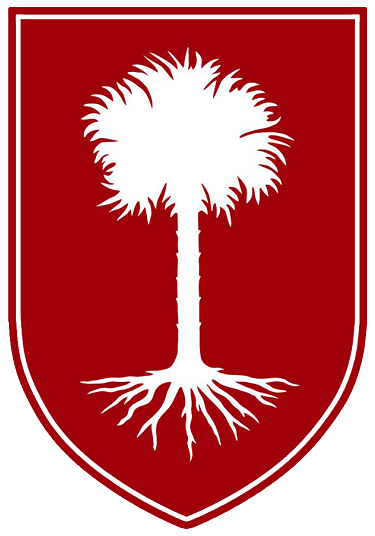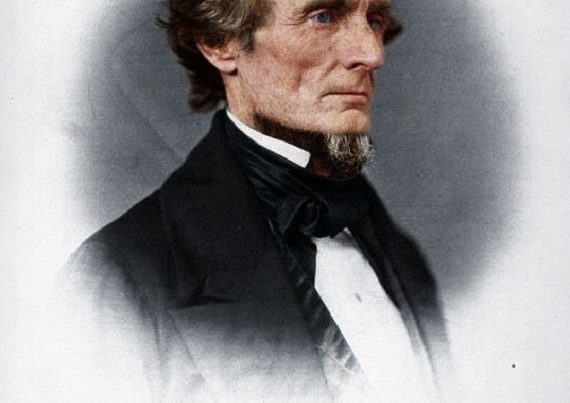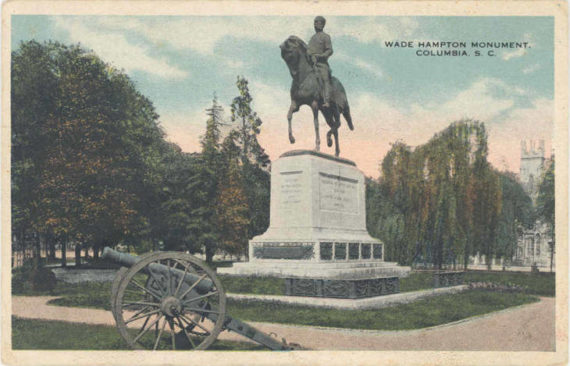On July 11, 1875, “Old Billie”, the former body servant of Confederate General Henry L. Benning, led Benning’s horse over eight blocks to Linwood Cemetery, the “Old Rock’s” final resting place in Columbus, Georgia. “Old Billie” proudly wore his Confederate grey coat as he followed Benning’s hearse on the slow march to the family plot in Linwood. Benning died of a stroke the day before, and the city was in shock. “Old Billie” collapsed with grief. Hundreds, if not thousands, took part in the funeral procession, including large numbers of the city’s black residents, along with hundreds of former Confederate soldiers, many of whom served in “Benning’s Brigade” during the War.
The Columbus Enquirer described the event:
Columbus, in all its history, has never witnessed such a numerous multitude of sorrowing citizens in the funeral train of any of its dead. The grief was universal. The high and the low, the rich and the poor, black and white, all denominations and associations, religious, social, and military–all with heartfelt sorrow joined the solemn train as it moved towards the final resting place of their friend.
His daughters commissioned a simple headstone for their father. It read: “Major General Henry Lewis Benning/Old Rock/This Was a Man.”
“This Was a Man.” No higher honor could be bestowed upon a soldier in the nineteenth century. Benning lived among men of action in a time of action, men who regarded duty, honor, integrity, courage, and sacrifice as the highest achievements. But Benning “was a man” before he faced fire on the battlefield. According to contemporaries, his word was an oath, and his duty and dedication to his family and community reflected a commitment to his faith and ancestry. Benning remembered who he was.
But to contemporary historians, this cannot–and must not–make sense. The”Naming Commission’s” final report making the recommendation to rename “Fort Benning” exemplifies the currently triumphant reductionist, activist version of Henry L. Benning:
The installation was named after Henry L. Benning, a lawyer, ardent secessionist, bitter opponent of abolition, and senior officer in the Confederate Army. He is on record as saying that he would rather be stricken with illness and starvation than see slaves liberated and given equality as citizens. As the commander of the Benning Brigade, he fought in many of the battles throughout the war. Heartbroken over the Confederacy’s defeat, he was one of the last officers to lead his men to the surrender ceremony in 1865.
This brief summary of his life contains elements of truth, but it also relies on the emotional “Righteous Cause Myth” and a false dichotomy between an enlightened North and an evil South.
Benning was a lawyer, an “ardent secessionist”, an opponent of abolition, a General in the Confederate military, and a “racist”. But this statement lacks context and is an oversimplification clearly intended to drive a narrative. For example, were Benning’s comments on race heretical in the nineteenth century? No. Republicans, including Abraham Lincoln, made similar arguments or said far worse. Most Americans opposed immediate abolition, even in the North. Lincoln never suggested in 1861–the year Benning made his comments about “illness and starvation”–that slaves should be given “equality as citizens”. In fact, Lincoln went out of his way to persuade the South that he supported slavery where it already existed and did not intend to give black Americans any political or civil rights. His home State of Illinois prohibited blacks from living there on the eve of the War.
Of course, the”Naming Commision” wanted the reader to believe that Benning was a “racist traitor” without explaining or defining “treason.” This was common both during and immediately after the War. The “Naming Commission” would suggest that our understanding of Benning was tainted by the “Lost Cause” while simultaneously relying on partisan Northern sources for their narrative of events. Southerners were called traitors by Northerners during the War. Only two men were tried in court for treason after the War. Both were either acquitted or found not guilty, meaning not even Northern courts thought they had a case. Southerners who exercised self-determination were only “guilty of treason” in the Northern court of public opinion, the court the “Naming Commission” relied upon for their subtle stab at Benning’s character. The charge was legally dubious both then and now.
But this raises an important question. Who was the real Henry L. Benning?
A far more complex man than the “Naming Commission” would want anyone to know. It would have undermined their pithy history. In fact, their story relied upon American ignorance of the man to advance their agenda.
Benning was born on 2 April 1814 in Columbia County, Georgia, on his family’s plantation. Both his father and mother traced their lineage to early Virginia, while his mother was descended from the Meriwether and Lewis families. Both family patriarchs served in the American War for Independence. They were reared in a society that embraced the best of Western Civilization. Men were expected to be educated gentlemen who defended the honor of their family and society; women graced the home with beauty, refinement, and children. Both sexes were educated to the standard of the day. Benning later said that women were great “readers” who could converse on any topic they encountered in text. Benning was no knuckle-dragging brute, nor was his wife an uneducated dolt. Her first cousin, Augusta Jane Evans, received a similar education and became one of the best selling novelists of the nineteenth century. Even modern educated readers would need a good dictionary, thesaurus, and firm grasp of history to understand her references.
Benning was educated at the Mt. Zion in Hancock County, Georgia under the direction of Presbyterian Minister Nathan S.S. Beman. Beman was born in New England and settled in Georgia during the War of 1812. He was a stern educator who eventually married the mother of ardent “fire-eater” William Lowndes Yancey. Beman moved to New York in 1823 and denounced secession in several sermons during the War in the 1860s while his stepson was leading Alabama out of the Union. Benning received a classical education at Mt. Zion and at seventeen enrolled at Franklin College, now the University of Georgia. He excelled in academics, joined the famous Phi Kappa Literary Society, and was graduated in 1834 as his class valedictorian. After graduation, he studied law and was admitted to the Georgia bar in 1835. His father acquired land in Harris County, Georgia while Benning was in Athens, and thus he joined his family in the Columbus area when he accepted a job at a Columbus law firm partnered by his former law tutor.
While the Benning family owned a large estate on the Chattahoochee River, they would have been considered “yeoman” or “middling” planters. Columbus in 1835 was a frontier city regularly faced with Indian attacks and dangerous floods. But it was also a growing city that offered the enterprising young Benning financial opportunities. His best financial move was marrying Mary Howard Jones, daughter of former Indian agent, Congressman, planter, and lawyer Seaborn Jones. Mary Jones was the model Southern belle: refined, educated, beautiful, cultured, and from a prominent family. Seaborn Jones was one of the wealthiest men in Muskogee County, and his home, El Dorado, served as a social hub of the city. Jones entertained presidents, generals, congressmen, and judges, and the young Benning couple would call El Dorado home until after the War. In the twentieth century, Margaret Mitchell modeled the character Scarlett O’Hara after Mary Benning.
Benning took an interest in politics and during the 1840s and 1850s often commented on his desire to enter the political fray. This led to several unsuccessful attempts to secure elected office throughout the “sectional conflict”. Benning began urging secession long before it became fashionable or popular. Modern critics describe Benning as a determined pro-slavery ideologue whose singular interest in slavery dictated his political positions. Benning centered his defense of the South on the institution. The combined estates of the Jones and Benning families counted over 100 slaves, making them one of the largest slaveholding families in Columbus. But Benning was only a “planter” because it provided residual income. The law occupied most of his attention, and while he grew cotton at his Chattahoochee River plantation, his father-in-law used his plantation to grow food for his slave population, most of whom were skilled artisans. Benning grew up in a slaveholding family, believed abolition to be a dangerous prospect (he, like other Southerners feared a Haitian style insurrection in the United States), and thought slavery was a vital part of Southern life, but he was also what Eugene Genovese called a “paternalist” who regarded the slave community as part of an extended family. Benning was nursed by a slave and grew up around black people. Like virtually all white Americans in the nineteenth century, he believed blacks to be inferior, but unlike leaders of the Republican Party, he was comfortable around black Southerners and considered them part of Southern life. He did not “hate” black people. And unlike Abraham Lincoln, he never argued that they need to be shipped out of the United States.
The Benning and Jones families attended St. Luke Methodist Church in Columbus, and before the schism between Northern and Southern Methodists, the St. Luke congregation was integrated (blacks outnumbered whites) and the church ordained black deacons. Some slaves on the Benning plantation were educated, and Benning continued to care for ten former slaves after the War (along with several extended family members) even on a reduced income. When grilled by Congress during the Ku Klux Klan hearings in 1871, Benning argued that Klan activity in Georgia, particularly in Columbus, was virtually non-existent, and that the people of Columbus worked tirelessly to support the freedmen. He wasn’t lying. Union soldiers engaged in most of the political violence in Columbus, not her residents.
Benning never held elected office, but he was appointed to the Georgia Supreme Court in 1853, and he was the youngest man in history to hold a seat on the bench of the highest court in the State. He correctly reasoned that State courts were equal with federal courts, meaning that the Georgia Supreme Court was not an inferior court to the United States Supreme Court, nor were State courts inferior to any federal court. Benning considered Section 25 of the 1789 Judiciary Act to be a fatal blow to the original Constitution. The Richmond Junto–led by some of the most ardent “State’s Rights” advocates in American history–argued the same and attempted to litigate the issue in 1819. They failed in the Supreme Court case of Cohens v. Virginia, but Benning was undeterred.
In one of his more important rulings, Benning wrote:
The Supreme Court of Georgia is co-equal and co-ordinate with the Supreme Court of the United States, and not inferior and subordinate to that Court. That as to the reserved powers, the State Court is supreme; that as to the delegated powers, the U.S. Court is supreme; that as to the powers, both delegated and reserved–concurrent powers–both Courts, in the language of Hamilton, ‘are equally supreme’; and as a consequence, the Supreme Court of the United States has no jurisdiction over the Supreme Court of Georgia; and cannot, therefore, give it an order, or make it a precedent.
He argued that all federal court decisions, but particularly those from the United States Supreme Court, that violated federalism and “States’ Rights” were political rather than judicial and were issued to advance the powers of the central government at the expense of the States and ultimately the Constitution. Contemporary critics would describe this as “Lost Cause” propaganda, but Benning was simply channeling an older American tradition of decentralization and federalism.
Judge Benning entered the political arena during “Secession Winter.” As a man who advocated secession for over a decade, this was his opportunity to persuade Georgia and the rest of the South than secession was the rightful remedy for Lincoln’s election in 1860. Detractors typically cite his strident defense of slavery and opposition to abolition as evidence that slavery was the cause of the War. Benning thought the South would be forced to defend itself once out of the Union, and he unequivocally argued that slavery would be better preserved in a permanent Southern confederacy than in the Union. Columbus raised thousands of troops for the cause, including Benning and most of his kith and kin. Benning and his father-in-law sank their fortune into the new Confederacy. Benning was never a “sunshine patriot.” Of course, newly elected President Jefferson Davis insisted that the South wanted to be left in peace, and while Benning knew that war was the likely outcome of secession, the act itself did not constitute belligerence. Secession and war were separate issues, and not every man in the South shared Benning’s assessment of the political situation, even secessionists. Once the war began, Benning was critical of the Confederate draft, railed against policies designed to centralize power, and was almost court-martialed for refusing to obey orders.
But he was also loved by his men for his determined leadership during some of the worst fighting of the War. Benning served in both the Eastern and Western theaters and had a sterling military record during some of the most famous battles: Second Manassas, Sharpsburg, Fredericksburg, Chickamauga, and Gettysburg. Benning led his brigade into the heat of the “Devil’s Den” at Gettysburg and held the position for the Confederacy until forced to retreat. For a man who was once looked upon as little more than a “political general”, his skill in battle as a brigade commander was virtually unmatched during the War. Like Thomas J. “Stonewall” Jackson, Benning rallied his men when the fighting was fierce, earning him the nickname the “Old Rock.”
Benning lost the use of his arm during the Battle of the Wilderness in 1864, while several of his family members were killed or gravely wounded. He returned to the war near the end of Robert E. Lee’s dogged defense of Petersburg and was forced to surrender with Lee at Appomattox in April 1865. Before Benning returned to Columbus, the city was burned by Union General James Harrison Wilson. El Dorado was spared, but Benning’s other property was destroyed. Benning saw his personal wealth reduced by eighty percent during the War, and his wife struggled to keep the house in order while her husband and son were at war. Benning returned home to a shattered society. His only son was disfigured by shrapnel at the Battle of Sharpsburg, eventually went blind, and never fully recovered. He died one year before his father in 1874, unmarried, and rarely left his family home–he said he was irreparably “ugly”. Sensing that he could not maintain El Dorado after his father-in-law died in 1864, Benning purchased a smaller property in downtown Columbus and asked his family to move from his wife’s inheritance. The stress was too much for her. She died suddenly in 1868, possibly from a broken heart and the stress of Reconstruction, before the family had completed their move.
He worked hard to regain some of his financial success after the War. The people of Columbus held him in high esteem, and his law career was generally successful. One of his daughters married Samuel Spencer, a former soldier in Nathan Bedford Forrest’s cavalry, and the man often called “The Father of the Southern Railway.” Two others never married and continued to live and work out of the Benning home in Columbus well into the twentieth century on various civic and historical projects.
In 1918, the people of Columbus honored their most conspicuous son by attaching his name to “Camp Benning”, a newly created training installation for American soldiers heading off to fight in World War I. No one questioned the rationale. Military officials, both North and South, respected Benning’s service record and his devotion to his men during the War. When the “Camp” became a permanent “Fort” prior to World War II, Benning’s name remained. He was honored throughout Fort Benning as a leader who faced fire with his men in the worst circumstances and who bled with them. When his daughter had to parade down Broadway in Columbus behind a United States flag in 1918, once elderly woman along the route shook her fist at her and yelled, “I’m ashamed of you, riding down Broad Street behind that old rag!” Even fifty years later, the wounds of the War lingered for many Southerners.
A military installation in Columbus, Georgia deserved the name Benning. The city and the Benning/Jones family were tied together by generations of history, which is why the latest move to change the name “back” to Fort Benning falls flat.
The installation should never have been renamed, but changing the name from Fort Moore to Fort Benning to honor Fred G. Benning of Nebraska rather than Henry L. Benning is more embarrassing than the original renaming. At least Hal Moore had ties to the region and the Fort. Fred Benning never served at Camp Benning, and while he was by all accounts a decent man who served with honor and distinction during World War I, he did not have the same attachment to the Georgia or the South. And unlike Henry Benning and his wife Mary, Fred Benning was the son of German immigrants without longstanding connections the United States. The “restoration” of Fort Benning was little more than a bait and switch by the Trump administration to placate those calling for the end of wokism in the military. Unless the base is named for Henry L. Benning, the “Naming Commission” continues to win. This was no victory.
Benning’s life and legacy have nearly been forgotten, even by the people of the city he called home. That made it easy for the Naming Commission to change the name of the Fort without much public opposition. That’s an indictment of the modern historical profession. Their simplistic reductionist history is all anyone really knows about the man in 2025. Perhaps the Spartan inscription on his grave is a fitting crimination of modern society and the “Naming Commission” that removed his legacy. “This was a man” is an alien concept in modern woke America. Perhaps that, more than any other reason, is why the “Old Rock” had to go and why even Republicans could never restore his name. “Conservatives” who place their hope in the G.O.P. will always be disappointed. Benning would have agreed.







Excellent post. Thank you for sharing this story.
The cowards on the re-naming commission will go to their unmarked, unwept graves as cowards.
“‘Conservatives’ who place their hope in the G.O.P. will always be disappointed. “
If I’ve said it once I’ve said it a thousand times. And for at least a thousand reasons.
Great article. So sad that a liberal senator for Massachusetts could do so much damage to the legacy of the South. This was a man.
It seems to me that the naming commission raises an interesting Constitutional question. The presidential oath of office, prescribed by the Constitution,
speaks of “faithfully” executing the office of president. How does one “faithfully” execute a law passed in bad faith, as the rider to the defense appropriations bill that created the naming commission clearly was?
Wonderful tribute and reminder of the man and the civilization, that Henry L. Benning, “Old Rock”, so well represented and which we are resolved to honor. Thank you.
LEE is said to have favored four psalms: 23, 91, 120 and 144. In the latter three, David may be heard as a warrior for his God and his People. He sees God as his “rock” and “fortress”, permanently immovable and manifest protection against assault.
This unarguable image of our God was universally accepted in Gen. Benning’s time and by his men. So, when his Christian soldiers, who fought and bled with him in battle for their very way of life, their homes and their People, called him “Old Rock”, they were consciously bestowing a highest honor. It is fitting that his tombstone should feature the remarkably honorific title, that his brave men gave their brave general.
As I read the article, Psalm 144 seemed to leap from it… for the psalm’s use of the terms “rock” and “fortress” … and for it’s description of the worthy impetus, which impels worthy men to war in defense of kith and kin.
I believe if the reader were to open up his Bible and refresh his acquaintance with Psalm 144, my point, so feebly stated by me, would be made much clearer and stronger.
Again, thank you for an excellent article.
I just started reading J. David Dameron’s biography of Benning a week ago, so this was very timely. I have to know more now.
Excellent piece from Professor McClanahan. Henry L. Benning has now become one of my favorite Southern heroes. Thank you, Abbeville Institute.